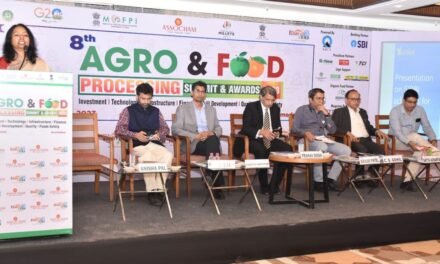In State Food Safety Index 2021, Gujarat, Kerala and Tamil Nadu were the top-ranking states while among the smaller states, Goa, Meghalaya and Manipur stood first. Among UTs, Jammu and Kashmir, Andaman and Nicobar Islands and New Delhi secured top ranks.
Union Minister for Health and Family Welfare Mansukh Mandaviya recently released the Food Safety and Standards Authority of India (FSSAI)’s 3rd State Food Safety Index (SFSI) to measure the performance of States across five parameters of food safety. The Minister felicitated nine leading States/UTs based on the ranking for the year 2020-21 for their impressive performance.
Gujarat, Kerala and Tamil Nadu were the top-ranking states while among the smaller states, Goa, Meghalaya and Manipur stood first. Among UTs, Jammu and Kashmir, Andaman and Nicobar Islands and New Delhi secured top ranks. The rankings were provided by the Ministry of Health and Family Welfare.
The State Food Safety Index is based on the overall performance of the States/ UTs in the previous financial year. This creates a positive competitive environment across the States/ UTs to meet the objectives of the Food Safety and Standards Act to provide safe food to consumers.
Table 1: Food Safety Index Rankings for Large States
| 1. Gujarat | 6. Himachal Pradesh | 11. Punjab | 16. Chattisgarh |
| 2. Kerala | 7. Madhya Pradesh | 12. Haryana | 17. Assam |
| 3. Tamil Nadu | 8. West Bengal | 13. Jharkhand | 18. Rajasthan |
| 4. Odisha | 9. Karnataka | 14. Uttrakhand | 19. Andhra Pradesh |
| 5. Uttar Pradesh | 10. Telengana | 15. Maharashtra | 20. Bihar |
Table 2: Food Safety Index Rankings for Small States
| 1. Goa | 3. Manipur | 5. Nagaland | 7. Tripura |
| 2. Meghalaya | 4. Sikkim | 6. Arunachal Pradesh | 8. Mizoram |
Also Read
TN Stands First in FSSAI’s State Food Fafety Index 2022
Table 3: Food Safety Index Rankings for Union Territories
| 1. Jammu & Kashmir | 3. Delhi | 5. Dadra & Nagar Haveli Daman & Diu | 7. Puducherry |
| 2. Andaman & Nicobar | 4. Chandigarh | 6. Ladakh | 8. Lakshadweep |
The State Food Safety Index measures the performance of States and UTs on five significant parameters of Food Safety:
Human Resources and Institutional Data (20% weightage)
The objective is to check availability of strong culture and ecosystem of enforcement commensurate with the size and population of the State/UT as well as participation of other departments and stakeholders in food safety activity at State and district levels. This parameter measures the availability of human resources like number of Food Safety Officers, Designated Officers, facility of adjudications and appellate tribunals, functioning of State/ District level Steering Committees, pendency of cases and their monitoring and participation in Central Advisory Committee meetings of the Food Authority.
Compliance (30% weightage)
This is the most important parameter and measures overall coverage of food businesses in licensing and registration commensurate with size and population of the State/UTs, special drives and camps organized, yearly increase, promptness and effectiveness in issue of state licenses/ registrations and monitoring of expired licenses. Also, this parameter considers the inspections carried out for high-risk food businesses, mode of inspections used and the number of samples lifted for testing. Promptness in attending to the consumer grievances and availability of help desk and web portals is also examined under this parameter.
Food Testing Infrastructure and Surveillance (20% weightage)
This parameter measures availability of adequate testing infrastructure with trained manpower in the States/ UTs for testing food samples. The States/ UTs with NABL accredited labs and adequate manpower in the labs score more in this parameter. The availability and effective utilization of Mobile Food Testing Labs and registration and utilization of InFoLNet (Indian Food Laboratories Network) are also examined under this parameter.
Training and Capacity Building (10% weightage)
This parameter focuses on training and capacity building of regulatory staff and laboratory personnel. Also, the workshops held with training partners, availability of training calendar and number of trainings held under FoSTaC (Food Safety Training and Certification)are examined in addition to the availability of trained Food Safety Supervisors in food businesses across the State/UT.
Consumer Empowerment (20% weightage)
This parameter measures the performance of States/ UTs in various consumer empowering initiatives of FSSAI like participation in Food Fortification, Eat Right Campus, BHOG (Blissful Hygienic Offering to God), Hygiene Rating of Restaurants, RUCO (Repurpose Used Cooking Oil), Clean Street Food Hubs, etc. Further, action taken for coverage of food fortification in open market, government safety net programmes and availability of fortified products in all districts are taken into consideration. State initiated activities for creating consumer awareness are also considered.
Further, action taken for coverage of food fortification in open market, government safety net programmes and availability of fortified products in all districts are taken into consideration. State initiated activities for creating consumer awareness are also considered.
Further, based on the need to compare similar States for generation of SFSI Index so FSSAI has classified States/ UTs into 3 categories (Large States, Small States and Union Territories). This will ensure comparability among similar entities.
The assessment and evaluation of each category has been done by separate teams comprising of outside experts for food testing and food and nutrition professionals in addition to FSSAI officials. The teams examined the details received and also interacted with States/UTs through web meetings.
ALSO READ:
If you found this article valuable, you may wish to receive our print version regularly. Subscribe now to receive the latest updates.
















